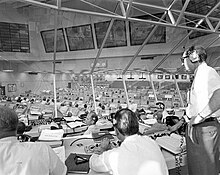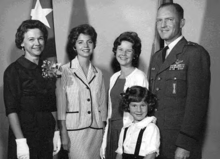Samuel C. Phillips
Samuel C. Phillips | |
|---|---|
Croix de guerre 1939–1945 (France) | |
| Alma mater | University of Wyoming (BS) University of Michigan (MS) |
Samuel Cochran Phillips (19 February 1921 – 31 January 1990) was a
A 1942 graduate of the
In 1964, Phillips was seconded to NASA as the director of the Apollo program. He brought in Air Force personnel to fill project management positions, and instituted common procedures, documentation and terminology, to prevent potentially catastrophic failures and oversights. An Apollo Configuration Management Manual was issued in 1964, which was largely copied from the Air Force Systems Command's manual. Phillips proposed a system of design reviews and change control that would give managers both the authority and the information necessary to manage the project. Daily reports were sent to headquarters, where they were kept by a central control room he modeled on the one that he had used on the Minuteman project. The Apollo program's mission was accomplished in July 1969 with the Apollo 11 Moon landing, and Phillips returned to the Air Force.
Early years and education
Phillips was born on 19 February 1921 in
Military service
On graduation from the University of Wyoming, where the
Phillips was given basic flight training in
After the war, Phillips was assigned to the European Theater headquarters in
Phillips returned to England in 1956, where he served with the
In July 1960, Phillips froze the design of Minuteman, precluding further design changes, even though he knew that its range was 1,000 miles (1,600 km) short of its specified requirement. It was estimated that it would take between six months and a year of further development to achieve this. Given a choice between meeting the specification and meeting the schedule, he chose the latter. In 1962, the first Minuteman missiles were based at Malmstrom Air Force Base in Montana, from whence they could still reach their targets even with the reduced range. The increased range was achieved in time for the second Minuteman wing to be equipped with the longer-range version. He also decided, on his own authority, to install field maintenance points on the missile so maintenance could be performed in the field. This was contrary to the original design, but based on his experience with the B-52, Phillips believed that it was necessary.[10]
NASA service
In 1963,

The following month, Phillips wrote to Schriever requesting that Air Force personnel be provided to fill program control positions in the OMSF. The AFSC sent two officers. Phillips then asked for 55 more. Such a large request prompted negotiations between NASA and the Air Force. The
Phillips aggressively took on the job with constant daily meetings, phone contact, and visits to contractor sites which kept him on the road 75 per cent of the time. He described the job to
I'm at the level which knows all the things you have to know to make a major decision. Below the program director, there isn't anyone who has the whole picture. Above the program director, the men have so many other responsibilities.[16]
Through the institution of common procedures, documentation and terminology, Phillips hoped to prevent potentially catastrophic failures and oversights, and to head off criticism from the media, Congress and the Government Accountability Office. An important step was the issuance of the Apollo Configuration Management Manual in 1964, which was largely copied from the AFSC's manual. Phillips proposed a system of design reviews and change control that would give managers both the authority and the information necessary to manage the project. Daily reports were sent to headquarters, where they were kept by a central control room he modeled on the one that he had used on the Minuteman project.[17]
In November 1965, Phillips personally took a
Phillips was also concerned about cost and schedule overruns at Grumman, which was building the Apollo Lunar Module (LM), and he sent a management review team headed by Wesley L. Hjornevik to Grumman headquarters in Bethpage, New York. The review team found fault with Grumman's management and procedures. Grumman adopted a system of "work packages", under which the project was broken down into discrete tasks, each with its own personnel, budget and manager, but this did not resolve all of its problems.[21][22] In February 1967, Thomas J. Kelly was replaced as project manager by Grumman vice president George F. Titterton, who was sent back from the executive suites to the factory building to manage the project.[23][22]
When the
The fire led Phillips to institute stricter measures to ensure quality and safety. Safety offices were established at every NASA field center in September 1967, and the following month the MSC created the Spacecraft Incident Investigation and Reporting Panel. The design of the first CSM and LM was frozen in October 1967, except for essential changes, which had to be approved by the MSC senior management board. Software changes were also restricted in February 1968. By this time, Phillips felt that restrictions had gone too far, and in October managers were permitted to approve minor changes, although any affecting schedules still had to be approved by the senior management board.[26]
With the Apollo project moving again, but seriously behind schedule, Phillips prevailed upon Webb to authorize sending Apollo 8 on a mission to orbit the Moon.[27] At a small dinner party before the launch of Apollo 10 in May 1969, Wernher von Braun, the director of the Marshall Space Flight Center in Huntsville, Alabama, praised Phillips as the one most responsible for pulling the many pieces of the Apollo program together and making them work on time.[16][6]
During the Apollo 11 mission in July 1969 which achieved the program's manned landing goal, Phillips announced his intention to leave NASA and return to Air Force duty.[6] During his NASA service, he was promoted to lieutenant general.[16]
Return to Air Force duties
In September 1969, Phillips assumed command of the
In the wake of the 1986 Space Shuttle Challenger disaster, NASA Administrator James C. Fletcher asked Phillips to lead a team to report on NASA's management. Phillips found that it had decayed since the days of Project Apollo, with the centers asserting their independence.[28] He recommended strengthening NASA headquarters' control, and placing both the Space Shuttle and Space Station Freedom under a single manager.[29]
Death

Phillips died of
Awards and honors
Phillips was a
Phillips was awarded the
On 26 September 1971, Phillips was awarded the
Notes
- ^ a b "Samuel Phillips – Recipient". Military Times. Retrieved 7 October 2021.
- ^ a b c d e f g h i j k l m n o "General Samuel C. Phillips > U.S. Air Force > Biography Display". United States Air Force. Retrieved 4 October 2021.
- ^ a b c d e f g Phillips, Samuel C. "Gen. Samuel C. Phillips Oral History: Part 1" (Interview). Interviewed by J. B. Kump. Embry-Riddle Aeronautical University. Retrieved 7 October 2021.
- ^ a b c d e United States Congress 1967, p. 3.
- ^ Bieber, Dana. "The man who led America to the moon: Gen. Samuel Phillips helped nation compete in space race". Made in Wyoming. Lee Enterprises. Archived from the original on 11 May 2009. Retrieved 11 October 2016.
- ^ a b c d Narvaez, Alfonso A. (1 February 1990). "Samuel C. Phillips, Who Directed Apollo Lunar Landing, Dies at 68". The New York Times. Retrieved 14 April 2010.
- ^ Maurer 1983, pp. 247–249.
- ^ Phillips, Samuel C. "Gen. Samuel C. Phillips Oral History: Part 2" (Interview). Interviewed by J. B. Kump. Embry-Riddle Aeronautical University. Retrieved 7 October 2021.
- ^ Bateman 2011, p. 41.
- ^ a b Bateman 2011, pp. 37–38.
- ^ a b Johnson 2001, pp. 696–697.
- ^ Hughes 1998, p. 118.
- ^ Johnson 2002, pp. 134–135.
- ^ Johnson 2001, p. 698.
- ^ Johnson 2002, pp. 135–137.
- ^ a b c Wilford 1969, p. 228.
- ^ Johnson 2002, pp. 137–139.
- ^ Johnson 2001, p. 705.
- ^ Johnson 2002, pp. 143–145.
- ^ Garber, Steve (3 February 2003). "NASA Apollo Mission Apollo-1 – Phillips Report". NASA History Office. Archived from the original on 31 October 2004. Retrieved 14 April 2010.
- ^ Johnson 2002, pp. 145–146.
- ^ a b Brooks, Grimwood & Swenson 1979, pp. 197–199.
- ^ Kelly 2001, p. 168.
- ^ Johnson 2002, pp. 145–147.
- ^ Kelly 2001, p. 163.
- ^ Johnson 2001, pp. 706–707.
- ^ Bateman 2011, pp. 39–40.
- ^ Bateman 2011, pp. 40–41.
- ^ Phillips, Samuel C. (30 December 1986). Summary Report of the NASA Study Management Group: Recommendations to the Administrator (PDF) (Report). NASA. Retrieved 8 October 2021.
- ^ "Gen. Samuel Phillips". Wright-Patterson Air Force Base. Retrieved 4 October 2021.
- ^ "Samuel C. Phillips: A Register of His Papers in the Library of Congress" (PDF). Library ogf Congress. Retrieved 4 October 2021.
References
- Bateman, Jeffery S. (Winter 2011). "The Ultimate Program Manager: General Samuel C. Phillips". Air Power History. 58 (4): 34–43. JSTOR 26276109.
- Brooks, Courtney G.; Grimwood, James M.; Swenson, Loyd S. Jr. (1979). Chariots for Apollo: A History of Manned Lunar Spacecraft. NASA History Series. Washington, D.C.: Scientific and Technical Information Branch, NASA. OCLC 4664449. SP-4205. Retrieved 20 July 2010.
- Hughes, Thomas P. (1998). Rescuing Prometheus. New York: Pantheon Books. OCLC 37792612.
- Johnson, Stephen B. (October 2001). "Samuel Phillips and the Taming of Apollo". Technology and Culture. 42 (4): 685–709. S2CID 109149778.
- Johnson, Stephen B. (2002). The Secret of Apollo: Systems Management in American and European Space Programs. New series in NASA history. Baltimore and London: Johns Hopkins University Press. OCLC 660823008.
- OCLC 492690341.
- Maurer, Maurer, ed. (1983) [1961]. Air Force Combat Units of World War II (PDF). Washington, DC: Office of Air Force History. ISBN 0-912799-02-1. Retrieved 17 December 2016.
- United States Congress House Committee on Science and Astronautics Subcommittee on NASA Oversight (1967). Investigation Into Apollo 204 Accident: Hearings, Ninetieth Congress, First Session. Washington, DC: U.S. Government Printing Office.
- OCLC 29123.
![]() This article incorporates public domain material from USAF biography. United States Air Force.
This article incorporates public domain material from USAF biography. United States Air Force.

